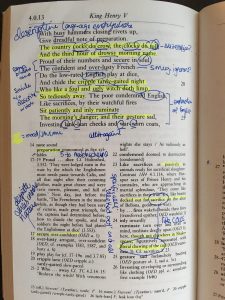The annotation process of film can be quite a drab and tiresome predicament for some. While this process is advantageous to place an emphasis on analysis rather than mere observation of a work, it can still be dull and monotonous. Nevertheless, often it is also a necessity to uncover underlying meanings, unique interpretations, or even one’s own perspectives on a particular matter. In my own consideration, the success of such note-taking varies entirely on the media that is examined, for while my practice of annotation for play-texts emerges quickly and almost entirely, film analysis is a much more lengthy and complicated exercise.
In most cases, I prefer the annotation of play texts as each can be reread, further analyzed, and considered multiple times in a short period. In terms of textual analyses of plays, I feel as if my own perception of ideas within the text are more thorough as their significance is clarified almost immediately and elaborated soon after. In the examination of a play text, I find it easiest and most efficient to read the text aloud, thus grasping a fuller understanding of the meaning behind each word used – particularly in the case of complicated language, such as that of Shakespeare. This not only provides the overt tone of the piece through the development of emotion, but entices my full focus on the material at hand instead of inciting distractions.  A play-text analysis also allows me to visually examine the content, rather than the relying on the necessity to view an interpretation while also listening to a passage. Such an appreciation of this is evident upon a simple examination of my texts, as they typically resemble overused and well-loved cookbooks, with explanations, highlights, interpretations, and connections. This practice provides me opportunities to recognize consistent themes, word usage, recurring expressions, and other textual elements. As a visual learner, each method of analysis is imperative to my understanding and development of meaning within a play-text, for it focuses not on an optical spectacle but rather a corporeal verse.
A play-text analysis also allows me to visually examine the content, rather than the relying on the necessity to view an interpretation while also listening to a passage. Such an appreciation of this is evident upon a simple examination of my texts, as they typically resemble overused and well-loved cookbooks, with explanations, highlights, interpretations, and connections. This practice provides me opportunities to recognize consistent themes, word usage, recurring expressions, and other textual elements. As a visual learner, each method of analysis is imperative to my understanding and development of meaning within a play-text, for it focuses not on an optical spectacle but rather a corporeal verse.
In terms of film analyses, my annotation process changes completely. I truly find it rather difficult to analyze critically as the film progresses, as I am drawn to the cinematic performance instead. I constantly find myself lost in the plot, and reminders to focus on the primary purpose of the examination are abound. However, with a degree of reprimand and a potential second-screening, my notebooks are better-filled with ideas, comments, and a number of questions. Even so, I often find it troublesome to elucidate on particular practices or ideas within the film due to its fleeting nature, rather than material state. As such, the approach that works best for me is to annotate simple ideas while watching and supplement them later. I aim to capture very rough conjectures that continuously surface, such as a particular mood or typical shot type, and further augment such theories following the screening. I am sure this is common practice for many, and certainly understand why this would be the case. Rather than detracting from the piece in the constant pursuit of a fully-developed concept before the end credits roll, it allows one to both participate in and analyze the screening simultaneously. However, in my case, I feel as if much of the annotation seems quite basic and trivial in terms of meaning, particularly if ideas are lost or forgotten in a film’s deliberation. While aspects such as colour, framing, typicalities of shots, or score are certainly of great import to a piece, much of these evaluations feel hollow in comparison to their profound counterparts. I consistently aim to develop postulations abounding in complexities and in-depth considerations, and though it takes a great deal of mulling and contemplation, ideas that appear to me as shallow or basic do gradually dissipate to uncover stronger understandings and conclusions.
While each may have their strong suits when examined critically, I believe their success cannot be determined entirely by quantity, but rather the quality of interpretation that is established. Both the annotation of play-texts and film allow for a deep exploration of literary concepts, although each process is completely unique in itself. My preference may lie with the medium of text-plays due to their intrinsically accommodating nature, but the analysis of film certainly has its merits as well. Regardless of the method that is undertaken in terms of inquiry, providing a comprehensive analysis is the primary purpose of each, and both may provide additional postulations to captivate and delight audiences.
Leave a Reply
You must be logged in to post a comment.